Alloa, Clackmannanshire, Scotland, UK 作者: 来源: 发布时间:2021-07-29
I. Population and Area
Continent: Europe
Country: The U.K
State/Province: Scotland
City/Town: Alloa, Clackmannanshire
Total Area: 3.293 (sq mi)
Population in 2016: 20.73 (thousand)
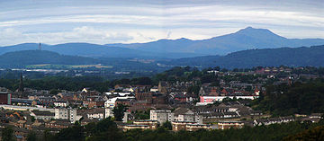
II. Natural Geography (environment and resources)
Transport
After the closure of the Stirling-Alloa-Dunfermline line in 1968 and the Devon Valley Railway in 1973, the town had no passenger railway services for 40 years until 2008. The Stirling-Alloa-Kincardine rail link project was completed in May 2008,. The laying of new track had commenced in September 2006 after much preparatory work, including new drainage works and the grouting of a large number of shallow mine workings. The project also involved the construction of a new bypass road, and a bridge which replaced a level crossing in the town. Alloa railway station reopened in May 2008, a short distance east of its former site, just beyond the location of the former junction to the Devon Valley line that served Tillicoultry and Dollar, and also carried through trains to Kinross and Perth.
Abellio ScotRail now operates an hourly service from Alloa railway station to Glasgow Queen Street via Stirling, Larbert and Lenzie between 0641 and 2241 Monday to Saturday and between 1041 and 2141 on Sundays. Passengers can travel to Inverness, Edinburgh Waverley and Aberdeen with a change at Stirling, however for journeys to or from Edinburgh passengers with heavy luggage may find it more convenient to change at Larbert, where Edinburgh and Glasgow services use the same platform.
The new railway opened for traincrew route learning in early April 2008, followed by the opening to the public on Monday 19 May 2008. This had been preceded by an official opening on 15 May 2008, where LNER Gresley K4 61994 The Great Marquess hauled four specials to Stirling. The return workings were hauled by Deltic 55022 Royal Scots Grey. Transport Minister Stewart Stevenson officially reopened the line.
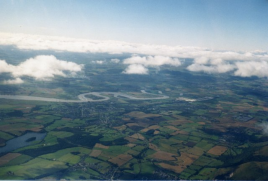
III. Economy
You're viewing live stats for Clackmannanshire vacancies from our database of over 1 million job ads. Here are some fast facts:

The average Clackmannanshire salary is £28,612.
Currently there are 163 live job ads in Clackmannanshire, out of 646,271 jobs nationally.
Most live job ads in Clackmannanshire are for Healthcare & Nursing Jobs and Logistics & Warehouse Jobs.
The top companies hiring in Clackmannanshire are Avon, AECOM and Mears Group PLC.
Salaries in Clackmannanshire have gone up 19.8% year-on-year while the national annual change is 4.3%
Clackmannanshire's Economy
Following the demise of traditional industries of mining, textiles and brewing, Clackmannanshire has undergone significant change in the past decade making Clackmannanshire an increasingly attractive place to live and work.
Economic Transformation
During the last decade major investment of over £400 million has secured valuable economic development in Clackmannanshire. This includes
Stirling-Alloa-Kincardine railway
Clackmannanshire Bridge
Quality housing developments
Major retail developments
3 new secondary schools
The employment base is no longer concentrated in the traditional sectors and, with high-quality business accommodation catering for all sizes of companies, Clackmannanshire has a growing number of small businesses.
Business Improvement Districts (BIDS)
In April 2008, Clackmannanshire became Scotland's first county-wide business park BID. The Clackmannanshire BID, Clacksfirst Ltd, covers 200 companies in 10 business parks which will benefit from efficiency improvements, cost savings and performance enhancements.
Another BID for Alloa Town Centre, ATC Ltd, has since been established to bring additional investment to enhance the image and facilities of the county's main town.
New College
In addition to the three new secondary schools and a new community health care centre, a new purpose-built college opened in 2011 making Clackmannanshire a place of increasing opportunity and growth.
Alloa Town Centre Regeneration
Clackmannanshire's main town has benefited from the Imagine Alloa project - £2.4 million of improvements to enhance paving and streetscapes including new public artworks and shop front enhancements to give Alloa a unique selling point and cohesive visual theme.
Challenges
The economic downturn has seen unemployment figures rise locally and we still have severe economic difficulties throughout the area, particularly in pockets such as South and East Alloa and Tullibody.
Reference Website:
https://www.clacks.gov.uk/business/localeconomy/
https://www.adzuna.co.uk/jobs/salaries/clackmannanshire
IV. Industrial Characterisitics
Major industries:
Wool
Wool was also locally plentiful and in the early part of the 19th century, John Paton set up a small yarn-spinning business in the town, later establishing Kilncraigs Mill. Much of the Kilncraigs complex has been demolished but a four-storey Edwardian Baroque block of 1903–4 survives, with an extension of 1936. The buildings were converted to Council offices by LDN architects in 2003/4. Patons merged with J. & J. Baldwin of Halifax in 1924 to become Paton & Baldwins Ltd.
Weaving and glass making
The town itself continued to be known for its weaving and glassmaking industries well into the 19th and early 20th centuries.
Brewing
Alloa was long associated with the brewing industry, with at least nine major breweries producing ales at its height. However industrial decline during the late 20th century has led to the economy relying more on retail and leisure. The first brewing firms in the town were Younger in 1762 and Meiklejohn in 1784. Alloa ale was sent to London and George Younger had an extensive export trade to the West Indies, Egypt and the Far East. Alloa was also home to Alloa Brewery Co, developing Graham's Golden Lager in 1927 which was renamed Skol in the 1950s. Closures and mergers during the mid-20th century reduced the number of breweries to two and by 1999 after the closure of MacLay's Thistle Brewery, only one remained, the Forth Brewery which became Williams Bros. in 2003.
Malt distilling
In addition to the brewing of beer, Alloa is the site of the former Carsebridge Distillery. According to Alfred Barnard, the Victorian historian of British distilling and brewing, the distillery was founded as a malt distillery by John Bald in 1799. In the 1840s it was converted into a grain distillery and by the time of Barnard's visit in the mid 1880s the distillery covered 10 acres, employed 150 people, and had an annual output of 1.4 to 1.7 million gallons of pure grain whisky. The distillery's owner John Bald and Co was one of five companies that combined to form the Distillers Company Limited in 1877. In 1902, a fire devastated the distillery, after World War I it was refitted and started producing yeast. This yeast production lasted until 1938. In 1956 the distillery was modernised, it expanded in 1966 and in the 1970s a new still house, cooperage and animal feedstuffs plant added. By 1980 the Carsebridge Distillery was the largest grain distillery in Scotland, however it closed in 1983 and was demolished in 1992. One of the distillery's Coffey stills is now in use at the Cameronbridge distillery.
Barrel cooperage
After whisky ceased to be produced at Carsebridge, the cooperage remained as one of two owned by Diageo in Scotland. In 2008, 30 people worked there rebuilding or repairing up to 400 bourbon casks, imported from the US, each day. However, in 2009 the company announced that it intended to close the Carsebridge Cooperage and move the work to nearby Cambus. The new Cambus cooperage was opened in December 2011 by the Earl of Wessex.
Military history
Alloa is linked to the historic Argyll and Sutherland Highlanders housed at Stirling Castle. Many of the soldiers in WW2 fought under Montgomery at the Battle of El Alamein and Wadi Akrit where their commanding officer Lorne Campbell won a V.C. They were part of the 7th Argylls under the 51st Highland Division.
Major projects and related introductions:
GSA
A team from The Glasgow School of Art will be working with the communities of Alloa as part of a major research project aimed at investigating energy challenges in the Clackmannanshire town it has been announced.
The project, which is led by the University of Stirling, has an overarching aim of understanding the everyday energy challenges facing disadvantaged communities and exploring – through engagement, collaboration and innovative co-creation – pathways towards a healthier, wealthier and greener future for local people.
The Glasgow School of Art’s expertise in co-design will be brought to the project with a team from the Innovation School set to work with the communities of southern and eastern Alloa exploring together how energy should be used, generated and shared in Clackmannanshire.
“Fuel poverty and climate change are important issues facing society,” says Gemma Teal, Research Fellow at The Glasgow school of Art. “The GSA’s Innovation School is delighted to be a partner with the University of Stirling and Clackmannanshire Council on this important project.”
Reference Website:
http://gsapress.blogspot.com/2020/02/news-release-gsa-innovation-schools-co.html
V. Attractions
1. Alloa Tower:
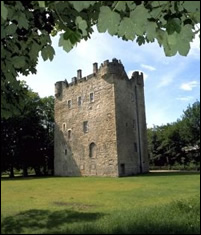
It was the home of the distinguished Erskine family, Earls of Mar, from the 15th century until c1800. By the late 17th century a mansion house and other buildings had been added. John, 6th Earl of Mar, made more changes, both modernising yet preserving the tower and mansion to complement an ambitious and extensive planned landscape around his home and stretching down to the River Forth. It was at this time the domed Italianate staircase leading to the Great Hall was added.
2. Castle Campbell:
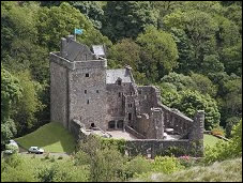
Castle Campbell has all the look of a fairytale castle set high among the rich woodland of Dollar Glen. Built on a high mound with steep ravines on three sides, the first sighting of this castle is truly breathtaking. ssentially a 15th century castle with later additions, the castle was acquired by the powerful Campbells of Argyll as a stronghold near to the Royal court at Stirling Castle. he castle is now managed by Historic Scotland, and admission tickets can be purchased from their website.
3. Heritage Centre:
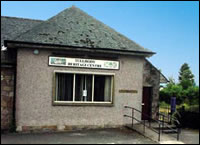
Tullibody is an ancient parish linked to Cambuskenneth Abbey. A church was founded there in 1149, and parts of the Old Kirk are probably of that date, though a date stone records its restoration in 1539. n 1833 it became a chapel of ease, but it was abandoned as unsafe in 1904 and unroofed in 1916. Two phases of restoration work on the Old Kirk have now been completed with the financial support of Historic Scotland and Clackmannanshire Council. Further restoration is being planned. ullibody is said to have been the site of Kenneth mac Alpin's camp before his battle with the Picts near Cambuskenneth in 834. After his victory he returned and erected a stone memorial. The stone stood to the west of the modern village and survived until the early 19th century. he village grew around the medieval church, but in c1800 the Abercromby family moved it. The core of the new village was around Main Street and the Tron Tree. 24 Main Street was the birthplace in 1811 of the botanist and geologist Robert Dick. In the 19th century a tannery was built and Tullibody began to grow.
Reference Website:
https://www.clacks.gov.uk/visiting/
VI. History
Alloa grew up under the protection of Alloa Tower which may have been built before 1300 AD. The name of the town has had different spelling at different periods. In the charter granted by King Robert the Bruce in the year 1315, to Thomas de Erskyne, it is called Alway; in some subsequent ones, Aulway, Auleway; and more recently Alloway. Dr Jamieson stated that the most probable etymology of the name was from Aull Waeg – the way to the sea.
14th century
Sir Robert Erskine was granted the lands of Alloa and its environs in 1368 for services to King David II and he and his descendants were good stewards, developing the estates and innovating.
17th century
One of the earliest maps of the area was made by surveyor and cartographer John Adair in 1681.
18th century
John Erskine, the 6th Earl of Mar oversaw many far-reaching developments including substantial harbour improvements, a customs house, a "New Town" area of housing,:111 and commissioning the building of the Gartmorn Dam, which was designed by George Sorocold.:101–107 Erskine owned many of the coal mines, and Robert Bald, a local mining engineer, was contracted to provide water power from the Gartmorn Dam to operate the mines and other industries. Good water supplies and the availability of barley from the carselands encouraged George Younger to set up a brewery in the 1760s and he was soon followed by others. Alloa became one of Scotland's premier brewing centres.
The 6th Earl of Mar was forced to flee the country and forfeit his lands after disastrously backing the Jacobite cause in 1715. However, his brother was allowed to purchase the forfeited lands and future generations continued the tradition of creative industry by launching a glass-works in 1750 and laying one of Scotland's earliest railways (a waggonway) from the Sauchie mines to down to the harbour in around 1766.
Before 1775, the colliers were attached to the properties in which they were born and were virtual serfs or slaves, supported by the master. After the Colliers and Salters (Scotland) Act 1775 abolished the system, the colliers could move between collieries at will, and they were supported in their needs by the Alloa Colliers' Fund or Friendly Society which was founded in 1775.
Traces of the waggonway and the Gartmorn Dam can still be seen today, and although the dam is no longer used for energy production or water supply, it is well used for fishing and leisure purposes. The Clackmannashire Library was founded at Alloa in 1797 and it contained upwards of 1500 volumes. As the 18th century closed a whisky distillery was established at Carsebridge by John Bald.
In the 18th century the staple business of the port was coal with about 50,000 tons a year exported.
19th century
In 1813 the first steamboat started to operate out of Alloa harbour. Rival companies later united into the "Stirling, Alloa and Kincardine Steamboat Company". In 1822 water was brought into the town and in 1828 a gas works was built. While building a road to Alloa Academy in 1828, an ancient burial site was found at Mars Hill, with several finds including two gold armlets. Alloa Academy was built in 1824, being paid for by subscription. The Alloa Swing Bridge was opened to the public on 1 October 1885.
20th century
After the improvements were made to the harbour during the 18th century, Alloa thrived as a river port through which the products of Glasgow manufacture were exported to continental Europe. At that time, and until the 1950s, the main industry to the north and east of the town was coal mining.
VII. Culture
Shopping
Alloa is served by many food retailers including Iceland Frozen Foods, Tesco, Aldi, Lidl, Morrisons, Asda, Co-op Food and Farmfoods. The Asda supermarket, opened in 2007, is adjacent to the site of the new railway station and was built on the land where the Alloa brewery once stood.
Religious sites
Alloa is currently served by two churches in the Church of Scotland, namely Alloa Ludgate Church (formed by the union of Alloa North Parish Church and Alloa West Parish Church in 2009 in the building of the former West Church) and St. Mungo's Parish Church. In 1978 the Very Rev Dr Peter Brodie (then minister at St Mungo's) was elected Moderator of the General Assembly of the Church of Scotland. Four other former St. Mungo's ministers have held this position. Its current minister, the Rev. Sang Y Cha, is the first Korean to be ordained to The Church of Scotland. Alloa is part of the Church of Scotland's Presbytery of Stirling.
The United Free Church of Scotland has a presence in Alloa through the congregation at Moncrieff United Free Church in Drysdale Street. The congregation is served by the Rev. Jason Lingiah and is part of the Presbytery of East.
On Greenside Street, in the old Greenside mission hall (a mission of Moncrieff United Free Church), is Alloa Elim Pentecostal Church.
There are churches of other denominations in the town, including a Baptist church, and St John's Episcopal Church. There are also congregations of Latter-day Saints and Jehovah's Witnesses in Alloa.
The Catholic church, also named St Mungo's, is located in Mar Street. The church is part of the Roman Catholic Diocese of Dunkeld.
There is a Musalla on Whins Road in Alloa. Muslims who are unable to attend a mosque can use this space as a place of prayer, worship and education. In 2003 it became open to the public.
Sports
Alloa is home to one professional football club: Alloa Athletic Football Club. The club was formed in 1878 under the name of Clackmannan County but changed to its present-day name of Alloa Athletic in 1883. The team currently play in the SPFL League 1 but recently competed in the Scottish Championship, formerly the Scottish Football League First Division, after being promoted as winners of a play-off with Dunfermline Athletic, the season after being crowned champions of the Scottish Football League Third Division at the end of the 2011–12 season. Their home games are played at Recreation Park in Alloa.
VIII. Other information
Alloa's most famous landmark is the 15th century Alloa Tower (National Trust for Scotland), the surviving part of the ancestral medieval residence of the Erskine family, the Earls of Mar.
Despite extensive internal and external alterations, the Tower retains its original medieval wooden roof and battlements, as well as some internal features. It is one of the largest and earliest of Scottish tower houses.
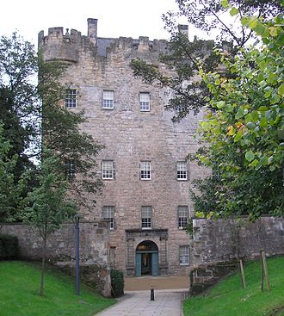
The town formerly contained a large number of 17th and 18th century buildings, but many were cleared with the expansion of milling operations and later with slum clearance in the 20th century. However, Alloa does retain some historic architecture in the form of Alloa Tower, Tobias Bauchop's House (1695), Inglewood House, Gean House and Greenfield House.
Alloa Town Hall and Library was designed by the architect Alfred Waterhouse and built in 1886-9 at a cost of £18,008. The Speirs Centre was built as Alloa's swimming pool in 1895 and was designed by Sir John Burnet of Glasgow. The Sheriff Court is by Brown and Wardrop of 1862–5.
Alloa War Memorial (designed 1920 erected 1925) is by Sir Robert Lorimer with sculpture by Pilkington Jackson. The monument to the South African War is also by Lorimer (1904).
IX. Contact information
Mayor/Officer: Derek Stewart
Tel: 07980 007 187
Mail: dstewart2@clacks.gov.uk
Reference Website:
https://www.clacks.gov.uk/council/wards/clackmannanshirecentral/12/
